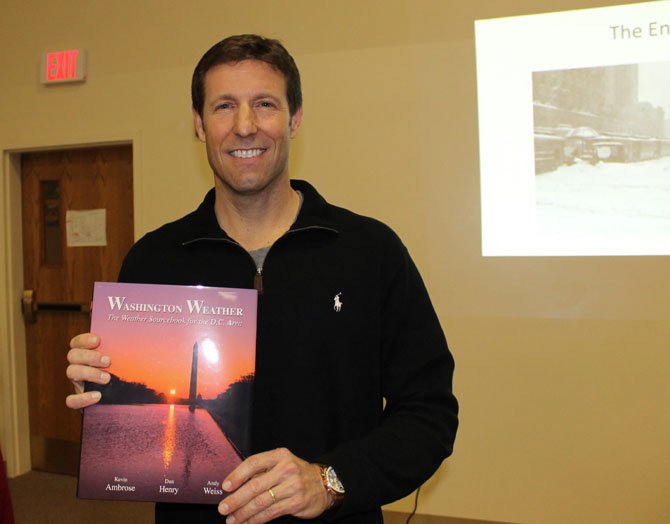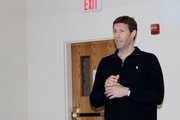Kevin Ambrose holds his book “Washington Weather” at a meeting of the Burke Historical Society on March 30. Photo by Janelle Germanos.
It was only fitting on a snowy Sunday in late March, following a winter filled with snow days, that members of the Burke Historical Society celebrate the beginning of spring by learning about the eventful Knickerbocker Snowstorm of 1922.
Kevin Ambrose, a contributor to the Washington Post’s Capital Weather Gang and author of several books about weather, gave the Burke Historical Society a look back at this snowstorm.
But before his account of this historic event, Ambrose talked about his experience as a writer for the Capital Weather Gang this winter.
“We’ve had just an amazing winter to cover,” Ambrose said.
Ambrose had written a couple articles on the Knickerbocker Snowstorm for the Capital Weather Gang, and was approached by a publisher. His book, “The Knickerbocker Snowstorm,” was published in January 2013.
According to Ambrose, the snowstorm was the biggest on record to hit the city of Washington, D.C. Nearly 30 inches of snow fell in Fairfax County.
The Knickerbocker Snowstorm was named after an incident that occurred at a famous Washington, D.C. theater. On Jan. 28, 1922, the roof of the theater collapsed, killing 98 people and injuring 133.
“The only thing that was really a positive was because of the storm, the theater was only half full, so it could have been worse,” Ambrose said.
Ambrose shared the stories of some of these victims and survivors, many of which were filled with tragedy but a few with happy endings.
“From the outside street level, it looked like nothing was wrong. Literally the roof just completely went down flat. The shell of the building was really untouched,” Ambrose said.
The snow’s weight caused the roof to collapse, resulting in one of the worse disasters in the history of the city.
The U.S. military led the rescue effort. George Patton was even involved, although the U.S. Marines had already been at the scene for hours before Patton arrived as part of the U.S. Army.
“One thing a lot of people don't know is that Washington, D.C. literally has a shadow government,” said Don Williams, vice president of the Burke Historical Society.
Sad stories included that of Agnes Mellon. Mellon died in the incident, but her fiancé survived.
Charles Lyman was planning to attend the show that night, Ambrose said, but his parents made him stay in and finish his homework. Unfortunately, his cousin David was at the show and died.
In addition to talking about the theater incident, Ambrose compared the snowfall of the Knickerbocker Snowstorm to other major storms in the Washington, D.C. area. Thirty inches of snow was measured in Fairfax County during the Knickerbocker Snowstorm. In the “Snowmageddon” of 2010, Ambrose said 32 inches was measured at Dulles Airport.
Even though it was snowing outside, members of the Burke Historical Society enjoyed learning even more about the snowstorm.
“It’s one of the better events that we’ve had,” said Cindy Bennett, the group’s fundraising chair and a Burke resident. “Especially after this winter that we just had.”
For more information on the Burke Historical Society, visit www.burkehistoricalsociety.org.

